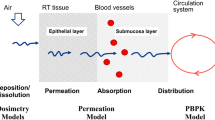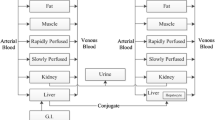Abstract
Physiologically based pharmacokinetic (PBPK) models have been developed describing the disposition kinetics of nicotine and its major metabolite, cotinine, in man. Separate 9-compartment, flow-limited PBPK models were initially created for nicotine and cotinine. The physiological basis for compartment designation and parameter selection has been provided;chemical-specific tissue-to-blood partition coefficients and elimination rates were derived from published human and animal data. The individual models were tested through simulations of published studies of nicotine and cotinine infusions in man using similar dosing protocols to those reported. Each model adequately predicted the time course of nicotine or cotinine concentrations in the blood and urine following the administration of nicotine or cotinine. These individual models were then linked through the liver compartments to form a nicotine-cotinine model capable of predicting the metabolic production and disposition of cotinine from administered nicotine. The potential for integrating this functional PBPK model with an appropriate pharmacodynamic model for the characterization of nicotine's physiological effects is discussed.
Similar content being viewed by others
References
R. W. D'Souza and H. Boxenbaum. Physiological pharmacokinetic models: some aspects of theory, practice and potential.Toxicol Ind. Health 4:151–171 (1988).
M. E. Andersen. Tissue dosimetry, physiologically-based pharmacokinetic modeling, and cancer risk assessment.Cell Biol. Toxicol 5:405–416 (1989).
H. Leung. Development and utilization of physiologically based pharmacokinetic models for toxicological applications.J. Toxicol. Environ. Health 32:247–267 (1991).
N. L. Benowitz and P. Jacob III. Metabolism pharmacokinetics, and pharmacodynamics of nicotine in man. In R. W. Martin, G. R. VanLoon, E. T. Iwamoto, and L. Davis (eds.),Advances in Behavioral Biology-Tobacco Smoking and Nicotine, Plenum Press, New York, 1988, pp. 357–374.
P. J. Murphy. Enzymatic oxidation of nicotine to nicotine-δ1(5)-iminium ion.J. Biol. Chem. 218:2796–2800 (1973).
J. W. Gorrod and P. Jenner. The metabolism of tobacco alkaloids. In W. J. Hayes (ed.),Essays in Toxicology 6, Academic Press, New York, 1975, pp. 35–78.
A. R. Hibberd and J. W. Gorrod. Nicotine-δ1(5)-iminium ion: A reactive intermediate in nicotine metabolism.Adv. Exp. Med. Biol. 136:1121–1131 (1981).
R. S. Obach and H. V. Vunakis. Non-metabolic covalent binding of nicotine-δ1(5)-iminium ion to liver microsomes and sulfhydryl-containing polyamino acids.Biochem. Pharmacol. 37:4601–4604 (1988).
K. S. Kim, J. F. Borzelleca, E. R. Bowman, and H. McKennis. Effects of some nicotine metabolites and related compounds on isolated smooth muscle.J. Pharmacol. Exp. Ther. 161:59–69 (1968).
J. F. Borzelleca, E. R. Bowman, and H. McKennis. Studies on the respiratory and cardiovascular effects of (−)-cotinine.J. Pharmacol. Exp. Ther. 137:313–318 (1962).
P. Dominiak, G. Fuchs, S. von Toth, and H. Grobecker, Effects of nicotine and its major metabolites on blood pressure in anaesthetized rats.Klin. Wochenschr. 63:90–92 (1985).
R. Chanine, A. Calderone, and C. Navarro-Delmasure. Thein vitro effects of nicotine and cotinine on prostacyclin and thromboxane biosynthesis.Prostaglandins Leukot. Essent. Fatty Acids 40:261–266 (1990).
G. A. Kyerematen, M. D. Damiano, B. H. Dvorchik, and E. S. Vessel. Smoking-induced changes in nicotine disposition: Application of a new HPLC assay for nicotine and its metabolites.Clin. Pharmacol. Ther. 32:769–780 (1982).
G. A. Kyerematen, M. L. Morgan, B. Chattopadhyay, J. D. deBethizy, and E. S. Vessell. Disposition of nicotine and 8 metabolites in smokers and nonsmokers: Identification in smokers of two metabolites that are longer lived than cotinine.Clin. Pharmacol. Ther. 48:641–651 (1990).
H. C. Porchet, N. L. Benowitz, L. B. Sheiner, and J. R. Copeland. Apparent tolerance to the acute effect of nicotine results in part from distribution kinetics.J. Clin. Invest. 80:1466–1471 (1987).
H. C. Porchet, N. L. Benowitz, and L. B. Sheiner. Pharmacodynamic model of tolerance: Application to nicotine.J. Pharmacol. Exp. Ther. 244:231–236 (1988).
F. Adlkofer, G. Scherer, L. Jarczyk, W. D. Heller, and G. B. Neurath. Pharmacokinetics of 3'-hydroxycotinine.Pharmacology of Nicotine. ICSU Symposium Series 9:25–28 (1988).
G. Scherer, L. Jaczy, W. D. Heller, A. Biber, G. B. Neurath, and F. Adlkofer. Pharmacokinetics of nicotine, cotinine, and 3'-hydroxycotinine in cigarette smokers.Klin. Wochenschr. 66 (Suppl 11):5–11 (1988).
N. L. Benowitz, P. Jacob III, R. T. Jones, and J. Rosenberg. Interindividual variability in the metabolism and cardiovascular effects of nicotine in man.J. Pharmacol. Exp. Ther. 221:368–372 (1982).
B. L. Lee, N. L. Benowitz, and P. Jacob III. Influence of tobacco abstinence on the disposition kinetics and effects of nicotine.Clin. Pharmacol. Ther. 41:474–479 (1987).
C. Feyerabend, R. M. J. Ings, and M. A. H. Russell. Nicotine pharmacokinetics and its application to intake from smoking.Br. J. Clin. Pharmacol. 19:239–247 (1985).
N. L. Benowitz, F. Kuyt, P. Jacob III, R. T. Jones, and A. Osman. Cotinine disposition and effects.Clin. Pharmacol. Ther. 34:604–611 (1983).
P. J. DeSchepper, A. V. Hecken, P. Daenens, and J. M. Rossum. Kinetics of cotinine after oral and intravenous administration to man.Eur. J. Clin. Pharmacol. 31:583–588 (1987).
M. Curvall, C. E. Elwin, E. Kazemi-Vala, C. Warholm, and C. R. Enzell. The pharmacokinetics of cotinine in plasma and saliva from non-smoking healthy volunteers.Eur. J. Clin. Pharmacol. 38:281–287 (1990).
J. D. deBethizy and M. E. Andersen. A physiologically-based pharmacokinetic (PB-PK) model for nicotine in the rat (Abstract).Toxicologist 10:862 (1990).
D. R. Plowchalk and J. D. deBethizy. A PB-PK model for nicotine tissue and plasma kinetics in the Sprague-Dawley rat (Abstract).Toxicologist 11:280 (1991).
J. Gabrielsson and U. Bondesson. Constant-rate infusion of nicotine and cotinine: A physiological pharmacokinetic analysis of the cotinine disposition, and effects on clearance and distribution in the rat.J. Pharmacokin. Biopharm. 15:583–599 (1987).
S. L. Schwartz, R. T. Ball, and P. Witorsch. Mathematical modeling of nicotine and cotinine as biological markers of environmental tobacco smoke exposure.Toxicol. Lett. 35:53–58 (1987).
R. T. Ball, O. Skliar, and S. L. Schwartz. CMATRIX, Georgetown University, Washington, DC, 1985.
D. I. Abramson.Circulation in the Extremities, Academic Press, New York, 1967, p. 207.
Q. P. Quiring.Collateral Circulation: Anatomical Aspects, Lea and Febiger, Philadelphia, 1949, p. 108.
C. F. Rothe. Venous system: physiology of the capacitance vessels. In J. T. Shepherd (ed.),Handbook of Physiology, Section 2, Vol. 3, Waverly Press, Baltimore, 1984, p. 397.
N. R. Davis and W. W. Mapleson. Structure and quantification of a physiological model of the distribution of injected agents and inhaled anaesthetics.Br. J. Anaesth. 53:399–404 (1981).
L. E. Gerlowski and R. K. Jain. Physiologically based pharmacokinetic modeling: Principles and applications.J. Pharm. Sci. 72:1103–1127 (1983).
L. R. Williams and R. W. Leggett. Resting values for resting blood flow to organs of man.Clin. Phys. Physiol. Meas. 10:187–217 (1989).
R. W. Leggett and L. R. Williams. Suggested reference values for regional blood volumes in humans.Health Physics 60:139–154 (1991).
N. L. Benowitz. Pharmacokinetics and pharmacodynamics of nicotine. InPharmacology of Nicotine. ICSU Symposium Series 9:3–18 (1987).
H. Schievelbein. Nicotine, resorption and fate.Pharmacol. Ther. 18:233–248 (1982).
R. J. Sebalt and J. H. Kreeft. Efficient pharmacokinetic modeling of complex clinical dosing regimens: the universal elementary dosing regiment and computer algorithm EDFAST.J. Pharm. Sci. 76:93–100 (1987).
R. E. Notari.Biopharmaceutics and Clinical Pharmacokinetics, 4th ed., Marcel Dekker Inc., New York, 1987, p. 49.
D. W. Sepkovic, N. J. Haley and D. Hoffmann. Elimination from the body of tobacco products by smokers and passive smokers (Letter to the Editor).J. Am. Med. Assoc. 256:863 (1986).
M. Curvall and C. R. Enzell. Monotoring absorption by means of determination of nicotine and cotinine.Arch. Toxicol. Suppl. 9:88–102 (1986).
L. B. Scheiner, Clinical pharmacology and the choice between theory and empiricism.Clin. Pharmacol. Ther. 6:605–615 (1989).
M. R. Gastonguay, N. J. Balter, and S. L. Schwartz. A physiologically-based pharmacokinetic (PBPK) model of nicotine and three metabolites (Abstract).Pharmacologist 32:141 (1990).
N. Y. Li, Y. Li, and J. W. Garrod. Determinations of pKa and partition coefficients of nicotine and related compounds (Abstract). Abstracts of IUTOX Satellite Meeting on Absorption, Distribution, Metabolism and Excretion of Nicotine and Related Alkaloids, Salsomaggiore Terme, Italy, 1992.
Author information
Authors and Affiliations
Rights and permissions
About this article
Cite this article
Robinson, D.E., Balter, N.J. & Schwartz, S.L. A physiologically based pharmacokinetic model for nicotine and cotinine in man. Journal of Pharmacokinetics and Biopharmaceutics 20, 591–609 (1992). https://doi.org/10.1007/BF01064421
Received:
Revised:
Published:
Issue Date:
DOI: https://doi.org/10.1007/BF01064421




